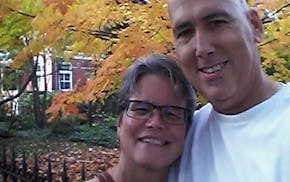The Great Minnesota Get-Together has done gone and Got-Together, in record numbers. I'm going to take this opportunity for a small critique.
My companion to the Minnesota State Fair last week was excited about the new transportation hub. We could take a bus and then rent an electric scooter at the bus stop so she could get around easily.
We got to the fair, and the hub was indeed impressive. We know because we got to walk the entire length of it, about 200 yards, from where the bus dropped us off to where the carts were stored.
My companion carried an oxygen tank and used a cane. I didn't think she would make it. An older woman stopped us as my companion rested, leaning on a garbage can.
"I can't believe how far it is to the gate," she said. "And no seats or benches to rest."
The woman, who said the bus driver said he couldn't drop her closer to the gate, leaned on the garbage can for a while to catch her breath, then resumed her trek.
My fair companion got so tired she contemplated resting in one of the portable toilets near the bus area. We finally got to the ticket booth and I got in line. My companion stood nearby for another 10 minutes or so. Again, no benches.
Rick Cardenas, co-director of Advocating Change Together and a longtime disability activist, already knew of the issue when I called him.
Cardenas has pushed for better services for disabled and senior Minnesotans at the fair for years. Two years ago he picketed the fair because few of the private companies hired to run buses have wheelchair access. The picketing by disabled activists has not changed that — "absolutely not, not changed whatsoever," said Cardenas.
"I have to believe there are violations of human rights and the Americans With Disabilities Act," said Cardenas, who also said some blocks are missing curb cuts for wheel chairs and carts.
A look at the fair's website on accessibility shows a vast array of services for the disabled, including shuttles from disability lots and even sign language interpreters. There is clearly a large effort to accommodate the disabled.
"It's gotten better," said Cardenas. "But it still needs some work."
Once inside the fair, things were fine. Lots of venues to accommodate people with mobility issues. My companion was impressed.
After my experience, I used social media to ask for anecdotes. While some respondents thought the fair did an excellent job on accessibility, others didn't.
At least three people contacted me to say that after assessing the transportation options, they decided against taking a family member to the fair. A reporter got a call from a woman who said the lines were too long for her disabled spouse to stand, and so they got back on the bus and went home.
Another issue is that motorized carts get sold out every day. You have to go early or get lucky.
This year, the company that supplies the carts and wheelchairs allowed reservations. So I called and reached an answering machine, which told me to leave a message and a return number.
I did, but no one ever called me back.
Julian Loscalzo said he had a partial solution to help seniors and people with mobility issues at the fair, but got turned down: Pedicabs, which he owns.
Loscalzo tried to get an agreement with the fair to station some of the Pedicabs near the exits, so that people could get rides to their cars in distant parking lots, or to the bus stations.
"I know my idea is a moneymaking enterprise and I'm going to make some money, but I still think it's a service we can offer," Loscalzo said. "About 50 percent of our riders are people with some type of mobility issues, but the fair won't allow us near the gates."
Usually when I call an organization with a gripe of mine or our readers, it gets defensive, but when I called Brienna Schuette in the fair's communications office, she was apologetic.
"Just to be very honest with you, this is the first year with the hub and there are a lot of tweaks we have to make before 2015," said Schuette. "We tried to think of everything."
Schuette said we'd probably have had better luck driving to the disability-only lot, where they do have shuttles to the door. Fine, but that conflicts with the fair's goal to get more people to use public transportation.
Schuette seemed genuinely sad that some people were struggling at the new transit hub, and said they would work on the issue for next year.
"We rely on feedback from the public," Schuette said. "It sounds like an easy fix to put benches [in the hub]. I'm glad you brought it to our attention."
Benches would be great. A service such as Pedicabs would also work, and perhaps a ticket line for people with disabilities. The number of fairgoers with mobility problems will only rise.
Fair officials might also consider golf carts driven by volunteers to help people reach the wheelchairs and electric scooters. If they do, I'll sign up for a couple of shifts.
While I'm offering unsolicited advice: Never, ever change the recipe for Pronto Pups.
jtevlin@startribune.com • 612-673-1702
Follow Jon on Twitter: @jontevlin

Tevlin: 'Against all odds, I survived a career in journalism'

Tevlin: Grateful Frogtown couple fight their way back from fire and illness



